Table of Contents
Cooking and Science
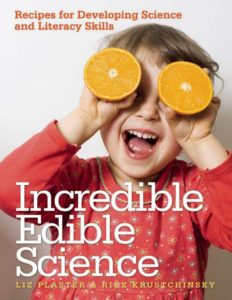
|
By Liz Plaster and Rick Krustchinsky, Incredible Edible Science (Redleaf Press, 2010) is a collection of 160 food-based science activities for preschoolers and early elementary students, categorized under observation (via the five senses: sight, smell, taste, touch, and sound), classification, communication, measurement, inference, prediction, and language and literacy. (Under this last, for example, kids make alphabet pretzels and Three Bears’ Porridge, and grow Jack’s beanstalk.) |
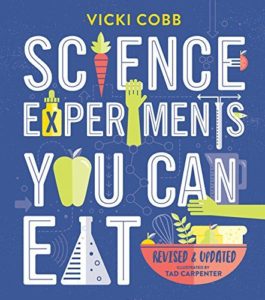
|
Vicki Cobb’s Science Experiments You Can Eat (HarperCollins, 1984) pairs interesting recipes with equally interesting scientific discussions: for example, kids make rock candy, grape jelly, and popcorn while learning about crystallization, polymerization, and steam pressure. Cobb is brilliant at making science accessible for a wide range of ages. (Get all her books!) Highly recommended. |
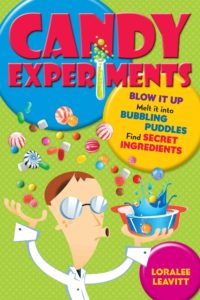
|
Loralee Leavitt’s colorfully illustrated Candy Experiments (Andrews McMeel Publishing, 2013) has a wealth of tempting and creative things to do with candy other than eat it. Discover candy’s secret ingredients, investigate candy color, experiment with density (find out how to sink a marshmallow), and try squashing it, stretching it, melting it, or blowing it up, all in the name of science. Included are complete instructions and explanations. For ages 7-12. |
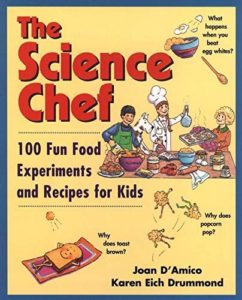
|
The Science Chef by Joan D’Amico and Karen Eich Drummond (Jossey-Bass, 1994) is a collection of “100 Fun Food Experiments and Recipes for Kids,” among them recipes and brief scientific information on salad dressing, pasta sauce, cheese, butter, and pudding. Readers learn why toasted bread turns brown and discover the chemistry of baking powder. For ages 9-12. |
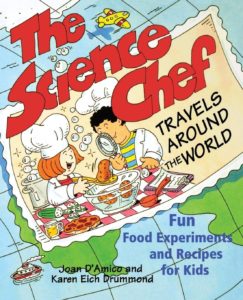
|
The Science Chef Travels Around the World by Joan D’Amico and Karen Eich Drummond (John Wiley & Sons, 1996) covers fourteen different countries, among them Brazil, Israel, China, India, Morocco, Canada, and Ghana. For each is listed an interesting science experiment based on a representative ethnic food – for example, kids learn about viscosity with honey (Egypt) and osmosis with pickled cucumbers (France) – along with recipes and menus. For ages 9-13. |
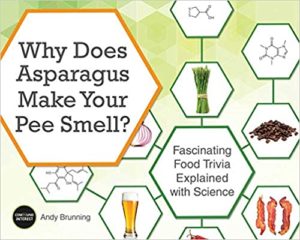 |
Andy Brunning’s Why Does Asparagus Make Your Pee Smell? (Ulysses Press, 2016) – subtitled “Fascinating Food Trivia Explained With Science” – is a large collection of short informational snippets (“Why Do Onions Make You Cry? Why Does Turkey Make You Sleepy? Why Does Garlic Give You Bad Breath?”), accompanied by terrific chemical graphics. For ages 12 and up. |
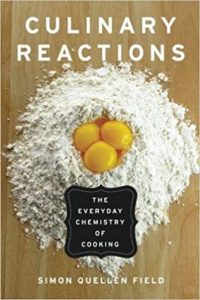
|
Simon Quellen Field’s Culinary Reactions (Chicago Review Press, 2011) is neither a chemistry book nor a cookbook, but rather a friendly and clearly written melding of the two, explaining just what goes on – chemically – in the process of making whipped cream, bread, meringue, hollandaise sauce, cheese, roast turkey, lemonade, and ice cream. (There’s also a nice account of how to extract DNA from your Halloween pumpkin.) Various chapters cover foams, emulsions, colloids and gels, oils and fats, solutions, crystallization, protein chemistry, acids and bases, oxidation and reduction, and more. For ages 14 and up – best for those with a little basic chemistry under their belts. |
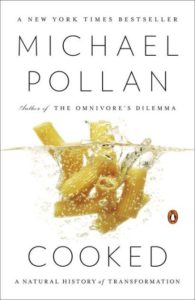
|
From the acclaimed author of The Omnivore’s Dilemma, Michael Pollan’s Cooked (Penguin Press, 2013) covers Pollan’s own experiences in learning how to cook, and explores the science of cooking – categorized by classical element : fire, water, air, and earth. Under “Fire,” Pollan learns to barbecue; in “Water,” he tackles soups and stews; “Air” is a study of bread; and “Earth” is all about fermentation and pickling. (Beer, cheese, and vinegar.) An interesting and informative read for teenagers and adults. |
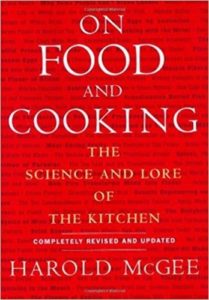
|
Harold McGee’s On Food and Cooking: The Science and Lore of the Kitchen (Scribner, 2004) is a terrific resource. The book, all 600+ pages of it, is jam-packed with historical and scientific information: for example, readers discover the history of graham crackers and chewing gum; learn about the biochemistry of meringue, mayonnaise, blue cheese, and ripening bananas; and find out how Brazil nuts are harvested and how bees make honey. Scientifically detailed and thorough; a good reference work for teenagers and adults. |
| For more interesting information on food science, see McGee’s excellent Curious Cook website. | |
| EdX’s Science & Cooking is a challenging and creative online course collaboratively taught by famous chefs and Harvard research scientists, complete with video lectures and virtual labs. The class can be audited or taken to obtain a Certificate of Mastery, which involves homework and exams. Either way it’s absolutely free. | |
| From the San Francisco Exploratorium, Science of Cooking has cool information, creative projects and activities, virtual labs, webcasts, and book lists on many aspects of cooking. Featured sections cover eggs, pickles, candy, bread, seasoning, and meat. A great resource. | |
| Cooking & Food Science Fair Project Ideas has many suggestions for science-minded cooks, categorized by difficulty level (Beginner, Intermediate, Advanced). For example, kids analyze the starch content of potatoes and the gluten content of wheat, determine the caloric content of foods, and explore the chemistry of ice-cream-making. | |
| From Penn State, Food Science has experiments, activities, lesson plans, and informative resources for kid in grades K-12. (Find out how to determine the speed of light with marshmallows.) | |
| From the American Chemical Society, Food and Cooking Chemistry has a range of cool experiments, mostly targeted at high-school kids. |
